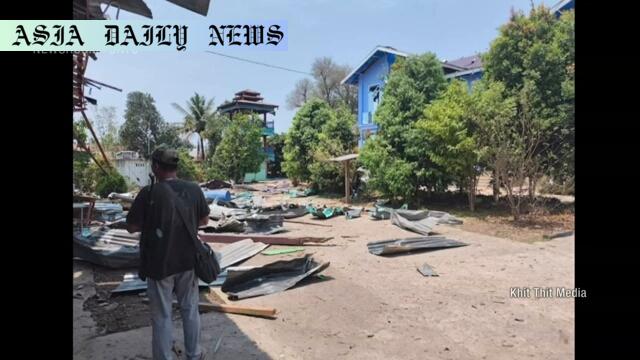Ceasefire: Myanmar’s military junta extends its truce until April 30 to aid earthquake victims, despite ongoing hostilities.
The military junta extends ceasefire until April 30 to support earthquake relief efforts.
Reports of ongoing airstrikes and civilian casualties in Sagaing contradict the ceasefire promise.
Humanitarian aid and relief efforts face challenges amidst persistent hostilities.

An Extended Ceasefire Amid Crisis in Myanmar
Myanmar is currently grappling with the aftermath of a devastating earthquake that struck the nation last month. With over 3,700 lives lost and 100 individuals reported missing, the natural disaster has left scars across the nation. In response, the military junta has announced an extension of the ceasefire with pro-democracy forces until April 30. According to the junta, this decision was made to facilitate critical relief operations and reconstruction efforts for the affected regions.
However, reports on the ground present a more complex scenario. Despite the declaration of a truce, several regions, including the northwestern Sagaing area, have witnessed ongoing military operations involving airstrikes. These actions contradict the declared ceasefire and have sparked condemnation from opposing forces and international observers alike.
Allegations of Violence Amidst a Pledged Truce
The pro-democracy factions, who oppose the military junta, have accused the government forces of undermining the ceasefire agreement through their actions. Civilian casualties have reportedly increased due to the intermittent airstrikes in conflict zones, particularly in Sagaing. Meanwhile, the military points fingers at rebel factions for continuing operations, including alleged drone attacks targeting military bases in the north and east of the country. These ongoing hostilities undermine efforts to provide much-needed humanitarian relief to quake victims.
The conflicting narratives add layers of complexity to the already volatile political and social landscape of Myanmar. Infrastructural damage caused by the earthquake, coupled with ongoing violence, has made it difficult for aid organizations to reach affected areas efficiently.
Challenges in Humanitarian Aid Delivery
The earthquake has devastated several communities, leaving survivors desperate for food, shelter, and medical assistance. Despite the ceasefire, thousands remain displaced and vulnerable due to the lack of infrastructure and ongoing instability. Reports indicate that critical aid supplies are struggling to reach isolated regions due to safety concerns for humanitarian workers and limited operational access. Aid organizations have called for international intervention to ensure safe delivery and distribution of resources to affected areas.
While the intention to extend the truce is seen as a positive step, its effectiveness is questionable in the current climate of mistrust and violence. Securing a sustainable solution requires negotiation, accountability, and a strong commitment from all parties to prioritize the needs of the affected population over political ambitions.
The Global Response and Need for Support
The international community has expressed concern over the dual crisis in Myanmar – the natural disaster and the ongoing political instability. Calls for humanitarian aid have intensified as relief efforts falter amidst reports of military aggression. Non-governmental organizations and international relief agencies are urging for a pathway that ensures the safety of aid workers and guarantees that relief reaches the most vulnerable populations without military interference.
As Myanmar struggles to navigate the twin crises, the path forward seems uncertain. Balancing the urgent need for humanitarian assistance with the ongoing conflict challenges traditional mechanisms of aid delivery. The need of the hour is for an inclusive approach that not only addresses the immediate crisis of relief and recovery but also provides a groundwork for long-term stability and peace.



Commentary
A Call for Action Amidst Crisis
The recent developments in Myanmar underscore a deeply troubling reality – the intersection of natural disasters and human-made conflicts can create an overwhelming humanitarian crisis. The devastating earthquake has left thousands grieving and displaced, yet the situation is compounded by ongoing violence and mistrust between the ruling military junta and pro-democracy forces. The extension of a ceasefire, while seemingly a step in the right direction, raises more questions than answers amidst reports of ongoing hostilities.
The Fragility of Ceasefires in Complex Conflicts
A ceasefire is often seen as a beacon of hope in conflict zones, but its effectiveness is rooted in genuine commitment by all parties involved. The conflicting accounts of airstrikes and drone attacks suggest that such commitment is yet to materialize in Myanmar. The ongoing violence not only undermines the truce but also hampers the delivery of critical humanitarian aid to earthquake survivors who direly need food, medical care, and shelter. This situation serves as a stark reminder of the challenges in implementing ceasefires in regions with entrenched political and social divisions.
The Role of the International Community
In crises such as this, the role of the international community becomes instrumental. Diplomatic pressure, coupled with coordinated humanitarian interventions, can make a significant difference in ensuring aid reaches the most vulnerable populations. For Myanmar, this is an opportunity for global leaders to step in and mediate, not just to deliver aid but also to foster dialogue for broader peacebuilding efforts.
Humanitarian Needs Must Prevail
Ultimately, the needs of earthquake victims must be prioritized above all else. Whether it’s through temporary ceasefires, international intervention, or a combination of both, ensuring relief reaches those in need is not just a moral imperative but a critical step toward rebuilding trust and stability in Myanmar. Policymakers, activists, and humanitarian organizations must work together to navigate these challenges and create pathways for hope and resilience amidst despair.